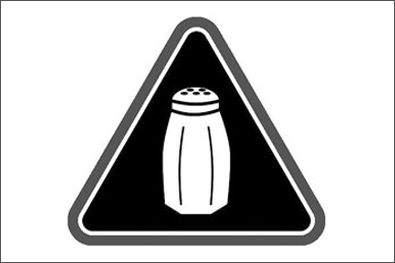In new research, a systems scientist and a health economist from the Academy’s Institute for Urban Health crunch the numbers to see how great an impact sodium reduction can have on improving health and lowering health care costs in the city.
Earlier this month, many New Yorkers were surprised to find a picture of a salt shaker beside many of their favorite chain restaurant menu items. The salt shaker warning is a new, New York City Department of Health and Mental Hygiene policy requiring chain eateries to attach the label to dishes with more than the recommended consumption of 2,300 milligrams of sodium per day. That means the little black and white shaker will appear next to about 10 percent of menu items.
 Reducing sodium intake is viewed as an important part of protecting health. High sodium intake is a major risk factor for hypertension — a health condition affecting about one out of every four adults — and a risk factor for stroke and heart failure. Yet, about 80 percent of New Yorkers consume more sodium per day than the recommended 2,300 milligrams. Dietary sodium intake also differs significantly among racial and ethnic groups, which may contribute to health disparities.
Reducing sodium intake is viewed as an important part of protecting health. High sodium intake is a major risk factor for hypertension — a health condition affecting about one out of every four adults — and a risk factor for stroke and heart failure. Yet, about 80 percent of New Yorkers consume more sodium per day than the recommended 2,300 milligrams. Dietary sodium intake also differs significantly among racial and ethnic groups, which may contribute to health disparities.
The True Value of Cutting the Salt
The relationship between sodium and health is complex. Hypertension and cardiovascular disease develop over many years making it difficult to measure the full impact of the warning. Nonetheless, implementing policy costs money so we decided to investigate the policy’s potential to improve NYC resident’s health over time. Evaluating the potential effects of new policy initiatives like this one is part of the Academy’s commitment to improving urban health through research, policy and practice.
Using computer simulation models that incorporate systems science and epidemiological evidence, we attempted a reasonable projection of the expected impact of the new high sodium warning.
We began by developing a model that allows us to estimate how many adults develop hypertension over time in a given location. The model was validated extensively with data from the Behavioral Risk Factor Surveillance System.
The first question we asked was: What would happen if adult New Yorkers did not change their eating habits? We simulated how hypertension would develop in the current population of the five boroughs over the next 20 years. We found that the proportion of the population with hypertension would increase from 32.2 percent to 46.7 percent in the Bronx; 29.2 percent to 43.2 percent in Brooklyn; 20.8 percent to 37.3 percent in Manhattan; 25.7 percent to 41.3 percent in Queens; and 26.7 percent to 41.8 percent in Staten Island.
We then conducted a similar simulation assuming that the new sodium reduction rule led people to cut their sodium intake by 30 percent. Though we had no way of knowing just how much sodium people would remove from their diets because of the high sodium warning, we did know that the average American consumes 3,400 mg of sodium each day. Cutting that number by 30 percent would bring it closer to the recommended 2,300 mg range.
On your plate, trimming 30 percent would be like swapping a serving of your favorite beef and cheese nachos, piled high with guacamole and sour cream (about 2,400 mg of sodium) for a nice grilled chicken sandwich.
Less Salt May Equal Longer Life
Here’s what we found. After a 30 percent reduction in the average daily consumption of sodium, the population with hypertension would decrease by 5.6 percent in the Bronx, 5.4 percent in Brooklyn, 6.3 percent in Manhattan, 5.3 percent in Queens, and 4.6 percent in Staten Island. That is, over 20 years, a 30 percent reduction would reduce the number of New Yorkers with hypertension by 58,978 in the Bronx,107,302 in Brooklyn, 87,397 in Manhattan, 96,807 in Queens, and 16,846 in Staten Island.
This is substantial, not only in terms of health, but also health care costs. The annual expenditures to treat hypertension are about $733 per adult. Thus, a reduction in the number of New Yorkers with hypertension (367,331 cases averted) will result in annual savings of about $67 million in NYC (about 25 percent of adults in the US receive treatment for hypertension). Besides these cost estimates, it is worth noting that total life expectancy is about five years longer for people who are normotensive, rather than hypertensive at 50 years of age.
Like weather forecasting models, computer simulations of chronic health conditions are imperfect in the sense that the models include many simplifying assumptions. In addition, our projections may overestimate the impact of this new rule because not everyone will change their dietary habits when they see a warning label. Even people who do make better choices at their local fast food chain, may still pile on the salt when they eat at home or in restaurants without a sodium warning.
Nevertheless, gently nudging people towards a lower sodium diet may be a good step toward helping millions of New Yorkers lead heathier lives. Our simulation predictions show that there would be a significant benefit to population health — and lower health care costs — if people cut their consumption of even one high sodium menu item per day. Clearly, small steps count!
View our COVID-19 Safety Protocols for attending NYAM public events.